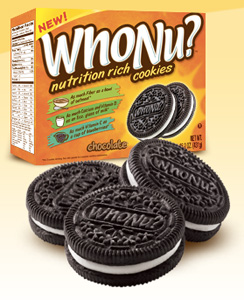I did!
The first time I saw the commercial of people excitedly enjoying a healthy cookie that resembled America’s favorite sandwich cookie I knew something was too good to be true. It usually is. This time was no different.
WhoNu Cookies claim to have as much fiber as a bowl of oatmeal, as much calcium as an eight-ounce glass of vitamin D milk, as much vitamin C as a cup of blueberries, as much iron as a cup of spinach, and even as much vitamin E as two cups of carrot juice. However, WhoNu Cookies are not anywhere near as good for you as any one of these foods. Frankly, they are far worse for you.
Their website does a great job of luring you in with these flashy selling points, but fails to show you what the actual ingredients are. I was hopeful to find a box that included these ingredients… you know… the way mom will hide spinach in lasagna or cauliflower puree in macaroni and cheese. That was not the case.
Instead, what I found was a complicated ingredient label like you’d find on just about any other package of cookies. The first ingredient is sugar, and we’ll admittedly give kudos for the second ingredient of wheat flour. But after that, just a bunch of junk we all need to stop eating. The third ingredient lists six different oils, one of which being partially hydrogenated, otherwise known as trans fat. Corn syrup also makes an appearance on the list.
A separate ingredient list shows a variety of vitamins and minerals. But without these being listed in line with the primary ingredient list, it’s hard to know how much, or really how little, of these are included.
Cookies are not healthy, and anyone who tries to tell you different is just duping you. There are “healthier” cookies, and if you’re going to indulge, try Back to Nature, Kashi, and Annie’s, a few examples of brands who’ve made it their mission to user better ingredients to make products that consumers can feel good about eating. Not only are their products using healthier ingredients, they proudly display them on their websites.
It’s time we all stopped falling prey to the advertisers and marketing speak fooling us into thinking the foods we’re eating are better for us than some alternative. Why can’t the food just BE healthy?
Sure it takes more time, but take a couple of minutes and read food labels while grocery shopping. You’ll be surprised how that side of the box differs from the side facing you in the aisle.
